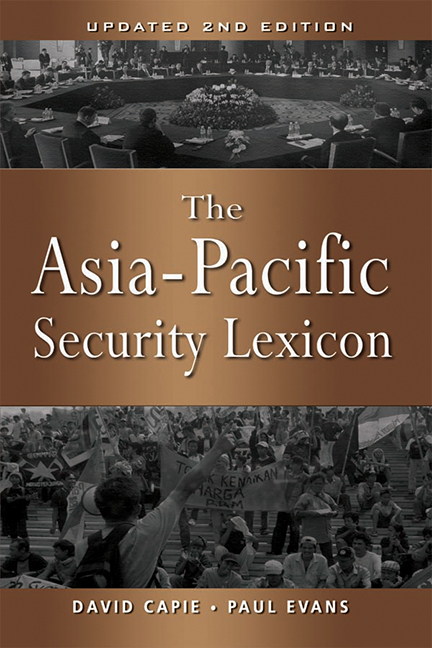Book contents
- Frontmatter
- Contents
- Abbreviations
- Introduction to the Second Edition
- Ad Hoc Multilateralism
- A la Carte Multilateralism
- The “ASEAN Way”
- Balance of Power
- Bilateralism
- Coalition of the Willing
- Coercive Diplomacy
- Collective Defence
- Collective Security
- Common Security
- Comprehensive Security
- Concert of Powers
- Concerted Unilateralism
- Confidence-Building Measures
- Confidence- and Security-Building Measures
- Constructive Intervention
- Cooperative Security
- Engagement
- Flexible Consensus
- Human Security
- Humanitarian Intervention
- Middle Power
- Multilateralism
- Mutual Security
- New Security Approach
- Non-Traditional Security
- Open Regionalism
- Peaceful Rise
- Pre-emption and Preventive War
- Preventive Diplomacy
- Security Community
- Terrorism
- Track One
- Track One-and-a-Half
- Track Two
- Track Three
- Transparency
- Trust-Building Measures
- About the Authors
Introduction to the Second Edition
Published online by Cambridge University Press: 21 October 2015
- Frontmatter
- Contents
- Abbreviations
- Introduction to the Second Edition
- Ad Hoc Multilateralism
- A la Carte Multilateralism
- The “ASEAN Way”
- Balance of Power
- Bilateralism
- Coalition of the Willing
- Coercive Diplomacy
- Collective Defence
- Collective Security
- Common Security
- Comprehensive Security
- Concert of Powers
- Concerted Unilateralism
- Confidence-Building Measures
- Confidence- and Security-Building Measures
- Constructive Intervention
- Cooperative Security
- Engagement
- Flexible Consensus
- Human Security
- Humanitarian Intervention
- Middle Power
- Multilateralism
- Mutual Security
- New Security Approach
- Non-Traditional Security
- Open Regionalism
- Peaceful Rise
- Pre-emption and Preventive War
- Preventive Diplomacy
- Security Community
- Terrorism
- Track One
- Track One-and-a-Half
- Track Two
- Track Three
- Transparency
- Trust-Building Measures
- About the Authors
Summary
A Singaporean academic once described the first edition of the Lexicon as “words from East Asian talk shops”. He may well be right. The book treats words seriously and, to paraphrase T.S. Eliot, continues to focus on their refusal to remain still.
The first edition of the Asia-Pacific Security Lexicon was completed in late 2001 and appeared in 2002. It seemed to find an audience. More than 6,000 copies were sold in four years and the book has been reprinted four times. A Japanese translation by Akiko Fukushima was published in 2003 and translations have also been produced in Chinese, Korean, Mongolian, and Vietnamese.
Our choice of terms in the first edition reflected a decade of creative institution-building and burgeoning multilateralism in the region. When we began research for the book in 1996, ASEAN had just seven members, the ASEAN Regional Forum was barely established and the first proposals for an East Asian regional grouping had been rejected six years earlier. By the time the book came out, we were able to look back on a decade in which multilateralism had taken root in the rhetoric and practice of Asia-Pacific security.
Yet by 2001 it was clear that some of the gloss had gone from regional multilateralism. An ineffective response to the Asian economic crisis, inaction over environmental problems and the disunity brought about by ASEAN's admission of new members, all raised serious questions about the effectiveness of cooperation on a regional basis. These doubts were compounded by the election in 2000 of a new U.S. administration that regarded multilateralism with deep scepticism, preferring bilateralism or ad hoc approaches to multilateral cooperation.
This growing ambivalence towards multilateralism was reflected in changes in the regional security discourse. ASEAN's traditional norm of non-interference was challenged by proponents of “flexible engagement” and “enhanced interaction”. The Bush administration's director of policy planning declared a preference for “a la carte multilateralism”. The changes were further compounded by the terrorist attacks in the United States on 11 September 2001 (9/11) and later bombings in Indonesia.
- Type
- Chapter
- Information
- The Asia-Pacific Security Lexicon (Upated 2nd Edition) , pp. xi - xvPublisher: ISEAS–Yusof Ishak InstitutePrint publication year: 2007



